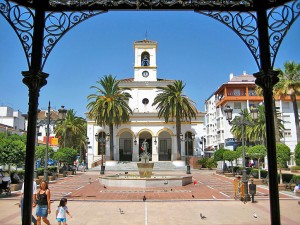
For a slice of Spanish tradition this Easter, why not head to San Pedro de Alcantara?
Santa comes but once a year. Across the Anglo-speaking world he’s a jolly fat man in a red suit with a rather lax approach to breaking-and-entry laws, healthy eating, and the laws of physics.
But in Spain, Santa comes a little later in the year and sticks around for more than a week. Semana Santa means Holy Week in Spanish, and is a celebration of Easter that is one of the most spectacular and hotly anticipated dates on the Spanish calendar…Andalucia is the place where the festivities are the most iconic, and nowhere more so than in Seville, where a flotilla of processions wind their way slowly through the city’s ancient streets all week. The displays range from the colourful and often humorous to the more sombre and serious, and are always impeccably observed in near-silence by the thronging, respectful crowd.
Elsewhere, Holy Week is the ideal opportunity for Spaniards to do what they do best – enjoy life in the company of family and friends. And while religious observance is an overt feature of Easter in Spain, there is enough secular flavour sprinkled across most gatherings to make them inclusive for all.
But with so much to see, do and experience, how do you narrow it all down into a manageable chunk of Easter-based fun? Luckily for VIVA readers, we’ve spent many years enjoying Semana Santa in Spain, and here are our five tips for making the most of this magical time…
1. Pick your procession
The main cities and towns of Andalucia all boast their own Easter procession, with Seville’s the most famous. Visiting Seville at this time is certainly something for the Bucket List, but it can be expensive and busy – especially if you require a hotel room in the city over the course of the processions.
For something a little less crowded, Malaga’s El Cautivo procession is well worth a look, as is the Cristo de los Gitanos celebration that is held every Easter in the hills of Granada’s Sacromonte barrio. Down in Cadiz there is a traditional brotherhood procession, while the pueblos of the Costa del Sol (particularly San Pedro de Alcantara) each host their own festivities full of dancing, singing, drinking and colourful celebration.
2. Soak up the sun
On the Costa del Sol, Easter traditionally marks the first stirrings of the summer season. Although still Spring-time, the mercury really seems to rev up around Semana Santa, and right on cue thousands of holidaymakers – many from northern Spain – descend upon the beaches of the Costa del Sol to enjoy the beautiful sunshine and early season warmth.
So why not join them? The resorts are less crowded than in summer, but still atmospheric; there is more space on the beach; the roads are clearer, and the sea temperature just about warm enough to enjoy a refreshing dip.
3. Head for the hills
Easter is a great time to explore the mountains that ring much of the resorts of the Costa del Sol. The fragrant pine hills that tumble down from near Coin, Monda, Ronda and Mijas are pockmarked with plenty of hiking routes that are ideal for all the family. The temperature is clement but not too hot, and the trails are often nearly empty, meaning you can enjoy many hours of solitude as you give your legs, lungs and eyes a gentle but rewarding workout.
Farther north, in the Sierra Nevada, the last remnants of the winter’s snow remain, so if you fancy catching some very late-season skiing then that is the place to head to.
4. Shop ‘till you drop
While Spain has numerous festivities and holidays throughout the year, few can quite match the Easter period for full-on opportunities to max out one’s credit card. Christmas remains a lower-key, family-oriented affair, while the summer season is one long period of outdoorsy fun and frolics.
At Easter, though, many stores hold generous sales, looking to attract the moneyed visitors from Madrid that head to the Costa del Sol during this time. So if you’re in need of some retail therapy, or simply want to treat yourself and your loved ones to some new clobber, then now’s the time to hit the brilliant stores of the Costa del Sol.
5. Kick back with family
If this is your first Semana Santa, prepare to be amazed at just how much time off work the average Spaniard takes. In addition to the generous national and regional holidays, many Spaniards will have planned a number of ‘bridge’ days well in advance, ensuring that they have at least three or four days off work during Holy Week.
And how do they spend this time? For many, Easter is the perfect time to spend with family, either in the privacy of one’s home (even more so if said home has a private garden and pool) or at any one of the excellent chiringuito restaurants that line the beaches of the Costa del Sol. It is a great idea to do likewise: to soak up the atmosphere, enjoy sublime cuisine and excellent service, and to really get into the spirit of what it means to enjoy Easter in Spain.
Whatever you choose to do this week, the team at VIVA wishes you a very happy Easter!
 en
en



 Vlaams-Nederlands
Vlaams-Nederlands
0 Comments
Leave a Comment
DISCLAIMER
The opinions and comments expressed by contributors to this Blog are theirs alone and do not necessarily reflect the views of VIVA Homes Under the Sun Ltd, any of its associated companies, or employees; nor is VIVA to be held responsible or accountable for the accuracy of any of the information supplied.
Have you got something to say?